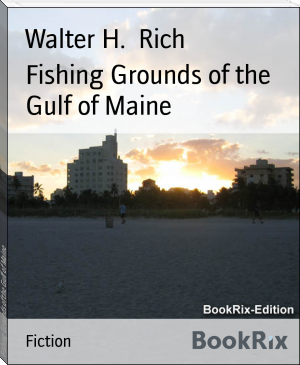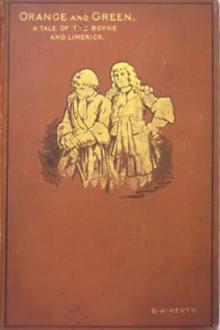Fishing Grounds of the Gulf of Maine, Walter H. Rich [readnow txt] 📗

- Author: Walter H. Rich
Book online «Fishing Grounds of the Gulf of Maine, Walter H. Rich [readnow txt] 📗». Author Walter H. Rich
Monhegan Outer Sou'Southeast. Three miles outside the Inner Ground on the same bearing and similar in size and form. The bottom is rocky and muddy or of hard clay. The depths are from 35 to 55 fathoms. The same species are found here as on Inner Sou'Southeast and at the same seasons, and in addition, hand lining is done for cod in August and September.
Blue Ground. This is SE 1½ E from Monhegan, distant 14 miles; E 1½ S from Portland Lightship 45 miles, and SW from Matinicus Rock 9 miles to southern Edge. Fishermen usually take the Monhegan bearing [12] for their starting point. This ground has a small shoal in the center, having 28 to 30 fathoms, from which the bottom slopes off to 45 and 60 fathoms on the edges. The shoal is broken and rocky, bu the deep water is over a level gravelly bottom. This ground is circular in form and about 2 miles across. It is both a small-boat and vessel ground, larger craft operating here mainly in the fall. Hake are found here in large numbers in summer and fall; cusk are taken in the deep water the year around but are most abundant in January. Cod are here the year around, the largest school occurring in February and March.
Monhegan Southeast Ground. This ground lies SE from Monhegan Island, the center distant 12 miles. This is nearly circular, 3 miles in diameter. The bottom is so broken that depths may vary much within a short distance, but depths are from 35 to 75 fathoms over a bottom of rocks, gravel and mud. Fishing is by trawl and handline. It is good cod ground from April to July; haddock are taken in December and hake in summer on the edges in 50 to 60 fathoms.
Hill Ground. This ground is SSW 9 miles from Matinic: between 3 and 4 miles long NE and SW and some 2 miles wide. The shoalest part has 35 fathoms and a rocky bottom. From this it slopes gradually to a depth of 50 fathoms over a bottom of mixed gravel, rocks and mud. Its best fishing is for hake, using both hand lines and trawls.
Monhegan Inner Sou'Sou'west Ground. this ground takes its name from its bearing, lying SSW from Monhegan light, distant 5 miles. Its width is 1½ miles, its length NNE and SSW is 1 1/4 miles. It has a sharp, broken, rocky bottom, including a small shoal of 20 fathoms and some hummocks of rather greater depths. The deepest water is in the neighborhood of 50 fathoms. Fishing here is from May until July for codfish and pollock: hake and cusk are in the deep water in the spring months and halibut on the shoal in July and September. This ground is principally fished by trawls, but there is considerable hand lining in September and October. Gillnetting, too, has become more common of later years.
Harris Ground. From 15 miles S ½ W from Monhegan island to 6 miles SSW. It has 40 to 50 fathoms over a bottom of sharp rocks and mud--a "blistery" bottom. Cod, cusk and hake are found here the year around. Halibut are here in June, July and August. Fishing is by trawling and hand lining, with very little gillnetting.
The 45 Fathom Bunch. Sixteen miles S 1½ E from Monhegan. This is a great ground for June hand lining for cod. Thence 1 mile ENE to 70 fathom depth, which leads to a piece of ground leading to the Inner Fall, on which, on a hard bottom and mud where there is an abundance of "lemons" and similar forms, are found cod cusk and pollock in June. The ground is about 6 miles long, WSW and ENE by 1 mile wide.
Another Forty Five Fathom Bunch lies 22 miles S ½ E from Monhegan. This ground is 4 miles long by 1 mile wide, running ENE and WSW, and has depths from 45 to 75 fathoms. This is likewise a great cod hand lining ground in June.
Another of the same name lies 26 miles S 1½ E from Monhegan. It has a 49 fathom shoal and the species and seasons are much the same as on the other grounds of the name. This is probably the ground known to other vessel captains as Toothaker Ridge.
Monhegan Outer Sou'Sou'West. This ground is SSW from Monhegan Light. the center distant 9 miles It is 4 miles long, NNE and SSW and about 2 miles wide, and has 45 fathoms on the shoalest part but the depths generally are from 60 to 80 fathoms. The bottom generally is gravelly and quite level. The ground is fished by both boats and vessels using hand lines and trawls.
This is a cod ground in spring and fall. In summer hake are abundant here, and halibut are quite plentiful in July on the shoalest part.
Old Jeffrey. An exceedingly good ground. It is said that better fishing may be had here than on any other ground of its size in the vicinity. This piece of bottom bears SE from Pumpkin Rock, from which the center is distant about 6 miles. It is about 3 miles long NE and SW, and about 1 mile wide. The bottom is broken, of gravel and mud, with depths from 25 to 50 fathoms. Fishing here is by trawling and land-lining. In spring cod are most abundant, in late summer and fall hake, cod, and pollock are taken. Halibut are found on the shoaler parts in July.
Little Jeffrey. A small piece of broken, rocky bottom, roughly circular in form. Depths average 35 fathoms. Species and seasons are as on Old Jeffrey, from which it lies about 4 miles NE by E.
Monhegan Western Ground. This is a somewhat extensive ground lying about 4½ miles WSW from Monhegan Island. The depths range from 22 to 45 fathoms. Its length is 4 or 5 miles, and its greatest breadth is 2 miles on the eastern portion, gradually narrowing westward to about 1 mile. The ground runs SE and NW. Pollock are found here in September and October. It is fished by hand lines, trawls and gill nets. Marks: Bring houses on New Harbor over the white cliff on Pemaquid 6 miles from New Harbor.
Broken Ground. The center bears nearly S. from Pumpkin Island (at entrance to Boothbay Harbor), distant 7 miles. It extends 4 miles in an ENE. and WSW direction and has an average width of 1¾ miles. Depths are from 35 to 50 fathoms on a bottom of rocks and mud. Cod are taken here the year around; hake from June to September. Cusk also are found here all the year in 40 fathoms depths. It is fair herring ground on spring nights.
Great Ledge. Ten miles S. from Cape Newagen. It is about 4 miles long, SSW. and NNE and from 1 to 2 miles wide. There is said to be a shoal of 14 fathoms on the northern edge and another of 22 fathoms near the center. These are both broken and rocky, but the main part of the ground, having depths of 30 to 45 fathoms, is mostly composed of sand. is quite level, and slopes gradually toward the edge. It is a good ground for cod and haddock in winter and for cod in the spring. A few pollock are taken here, also. Halibut are found on the shoals in July. On these, also, are good lobster grounds. It is chiefly a small-boat and vessel ground, fishing being done by hand lines and trawls, with some gill netting. Marks: Show the sawtooth of Morse's Mountain coming out by Seguin on the western side; hold this until Pumpkin Island comes onto White Island.
Barnum Head Grounds. These lie SSE. from Damariscove Island and are about 1 mile long by 400 yards wide. Depths are from 40 to 70 fathoms over broken ground of sharp rocks on the shoals, with mud on the deeper parts. This ground is fished by hand lines, gill nets, and trawls mainly by boats and small craft. Cod, haddock, and pollock are found here in the spring and fall months: hake in the muddy parts in summer. It is a summer hand-line ground for cod and pollock also. Marks: Bring the peak of Heron Island on Damariscove and the "Whistler" on Seguin, 7 miles from Damariscove Island (this gives 21-fathom soundings) or Big White Island's inner part just touching on Barnum Head; Morse Mountain (in Kennebec) touching on eastern part of Seguin to make a sawtooth.
Peterson's Ground. Lies distant SW. from Monhegan 20 miles and SSE. from Seguin 16 miles. This is about 3 miles long in an ENE. and WSW. direction by about 1½ miles wide. The northern and western edges rise sharply from the 85 or 90 fathoms of the muddy bottom about it to 60 fathoms over a bottom of rocks and stones. Easterly and southerly the ground slopes away gradually over hard gravel to 90 fathoms. Cod and hake furnish the best fishing here--at its peak during October and November.
Cusk Ridge. It lies S. ½ E. 12 miles from Pumpkin Island, 3½ to 4 miles long, NE. and SW., and 1/4 mile wide. This ground is somewhat difficult to find. It has a bottom of black gravel and rocks with 30 to 60 fathoms of water over it. A "blistery" bottom that is a cod ground the year around, the best of the fishing occurring in the spring months. Hake are abundant in the fall, and cusk fishing is exceptionally good in the deep water in June.
Potato Patch. Three miles WNW. from Monhegan. A round nubble about 14 mile in diameter, of sharp, rocky bottom having about 40 fathoms over it. Cusk and cod are taken on the shoal and hake from the muddy edges about it.
The Apron. Four and one-half miles from Monhegan. Marks are the tripod on Eastern Egg Rock over Franklin Island Light; Monhegan Light over the middle of Manana. Its length is 5 miles and its width 3 miles. It is a broken piece of ground with 10 to 45 fathoms. Cod are present the year around and haddock all the year except for a few weeks in summer. Cusk are here most of the year, but the season for pollock is September.
Henry Gallant Ridges. The inner one lies 16½ miles S. by E. of Monhegan Island, extending in a NNE. and SSW. direction, about 1 mile long by 1/4 mile wide. The outer ridge lies about 1¼ miles farther from the island on the same bearing as the first and paralleling it and apparently is about the same size. The bottom on both shoals is of gravel and black rocks with depths averaging 45 fathoms but rising from the 80 and 90 fathoms of the surrounding muddy ground. Both these are year-around cod grounds, the spring months, however, having The largest school. Cusk also are abundant on both shoals in the spring.
Mosers Ledge, also known as Middle Ground. This piece of shoal ground lies about midway between Monhegan Island and Pemaquid and has a 3-fathom shoal on the eastern part where the sea breaks in heavy weather. This shoal, called Mosers Ledge, is broken and rocky but slopes gradually to the SW., reaching 48 fathoms, with a bottom of gravel and mud on the deepest part. The ground is about 2 miles long NE. and SW. and about 1 mile wide. It is good ground for cod and haddock in the spring and for herring in June and other top-schooling fish In their season. Mackerel occur in late August and





Comments (0)